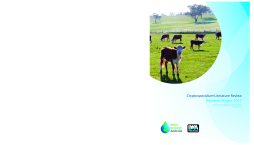
Additional Information
Book Details
Abstract
This report provides a review of the literature on Cryptosporidium and helps to identify the findings and formulates the key research questions. It covers these central questions:
- What are the sources/carriers of human pathogenic strains and what are the key species for a range of catchments?
- What is the contribution of pre and post weaned cattle and sheep to catchment contamination?
- What data on animal management practices (including vegetation management of riparian zones) is available?
- What are the different climatic zones across catchments and how will this impact on the survival and transmission of Cryptosporidium?
Table of Contents
| Section Title | Page | Action | Price |
|---|---|---|---|
| Cover\r | Cover | ||
| TABLE OF CONTENTS | vii | ||
| FIGURES | viii | ||
| TABLES | viii | ||
| 1 Introduction | 1 | ||
| 1.1 Background and Relevance | 1 | ||
| 1.2 Objectives | 1 | ||
| 2 FINAL REPORT | 2 | ||
| 2.1 What are the sources/carriers of human pathogenic strains and what are the key species for a range of catchments?\r | 2 | ||
| 2.1.1 Introduction | 2 | ||
| 2.1.2 Species and strains of Cryptosporidium infecting wildlife | 3 | ||
| 2.1.2.1 Wildlife Population density | 3 | ||
| 2.1.2.2 Volume of wildlife manure | 4 | ||
| 2.1.2.3 Marsupials | 4 | ||
| 2.1.2.4 Feral Pigs | 6 | ||
| 2.1.2.5 Deer | 7 | ||
| 2.1.2.7 Rodents | 8 | ||
| 2.1.2.8 Rabbits | 8 | ||
| 2.1.2.9. Foxes, wild dogs and feral cats | 9 | ||
| 2.1.3 Species and strains of\rCryptosporidium infecting domestic livestock | 10 | ||
| 2.1.3.1 Population density of domestic livestock | 11 | ||
| 2.1.3.2 Volume of domestic livestock manure | 11 | ||
| 2.1.4 Key species for a range of catchments | 12 | ||
| 2.2 What is the contribution of pre and post weaned cattle and sheep to catchment contamination?\r | 13 | ||
| 2.2.1 Cattle | 13 | ||
| 2.2.2 Sheep | 17 | ||
| 2.3 What data on animal management practices (including vegetation management of riparian zones) is available?\r | 19 | ||
| 2.3.1 Introduction | 19 | ||
| 2.3.2 Compulsory land acquisition by government and drinking water companies | 20 | ||
| 2.3.3 Restricting stock access to Riparian areas. | 20 | ||
| 2.3.4. Other strategies | 22 | ||
| 2.4 What are the different climatic zones across catchments and how will this impact on the survival and transmission of Cryptosporidium?\r | 24 | ||
| 2.4.1 Introduction | 24 | ||
| 2.4.2 Different climatic zones across catchments | 25 | ||
| 2.4.2.1 Sydney, New South Wales (NSW) | 26 | ||
| 2.4.2.2 Melbourne, Victoria (Vic) | 26 | ||
| 2.4.2.3 Adelaide, South Australia | 27 | ||
| 2.4.2.4 Western Australia | 27 | ||
| 2.4.3 Effects of climate on the survival and transmission of Cryptosporidium\r | 28 | ||
| 2.4.3.1 Temperature | 29 | ||
| 2.4.3.2 Desiccation | 29 | ||
| 2.4.3.3 Solar inactivation | 30 | ||
| 2.5 What are the key research gaps? | 31 | ||
| 2.6 Conclusions and perspectives | 32 | ||
| 3 References | 33 |
